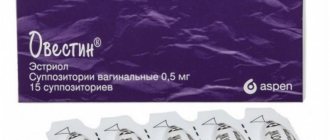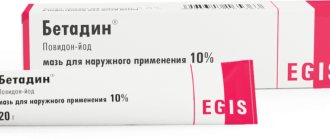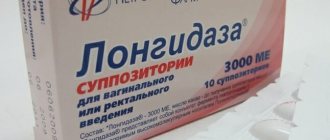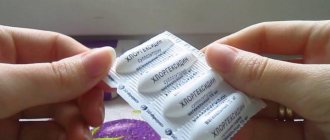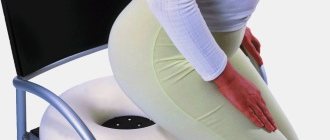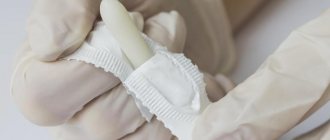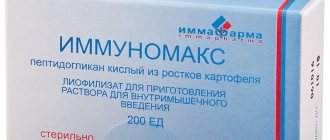Hexicon is a well-known drug that has been widely used for several decades in medical practice. This is a proven and reliable product that has several forms of release, including Hexicon ointment, which has antimicrobial and antiseptic activity. The ointment has a wide range of effects, it is an ideal remedy for healing wounds and skin lesions, and quickly cures various inflammatory skin diseases. The drug is often used in gynecology in the treatment of many female diseases and sexually transmitted diseases without disturbing the microflora. Moreover, Hexicon gel is used during sexual intercourse as a lubricant. The ointment can be used in dentistry, otolaryngology, as well as for disinfection and skin care after cosmetic procedures.
Release form
Hexicon suppositories are available in the form of suppositories, that is, they are solid at room temperature and melt at body temperature. They have the shape of a cylinder with a slightly pointed end. White color. The surface is smooth.
Suppositories are sold in cardboard packaging containing two contour cellular plates of 5 suppositories each. Instructions are also included with the drug.
Composition and appearance of candles
The basis of the composition of Hexicon suppositories is a substance such as chlorhexidine bigluconate.
This drug is produced on an antiseptic basis, the ability of which is to actively combat bacteria of such varieties as gram-negative type and gram-positive type.
This drug is also well suited for protection against sexually transmitted infections.
The main feature of these suppositories is that they do not have a negative effect on the normal microflora of the vagina, namely lactobacilli.
It is also worth noting that the bacteria are acid-resistant. This drug is not applicable if the discharge is accompanied by blood or pus. First of all, because Hexicon suppositories do not have the same effectiveness inherent in the drug.
The appearance of Hexicon candles resembles a torpedo. The color of the candles is yellowish, sometimes white. The package contains 10 suppositories. In some places of sale it is possible to purchase such a drug in the amount of one candle. In addition, in the box you can see special finger pads intended for one-time use.
Efficiency
Chlorine-hexidine bi-gluconate is an antiseptic that has a bactericidal effect, destroying bacteria. The mechanism of its action is that it destroys cell membranes by osmotic dissociation, that is, it promotes their disintegration into ions.
The drug is effective against many infectious bacteria, but is useless for treating viruses, acid-fast microorganisms, and fungi. In the vagina, the Hexicon suppository melts, enveloping the mucous membrane, without being absorbed into the bloodstream.
The drug Hexicon is used against the following bacterial infections:
- treponema pallidum (syphilis);
- chlamydia;
- ureaplasmosis;
- Genococcus bacteria;
- gardnerella;
- all types of bacteroid infections;
- trichomoniasis;
- simple herpes.
Suppositories work well even in the presence of pus and blood. Suppositories can also be used during menstruation.
The drug Hexicon, in addition to being antibacterial, has a spermicidal effect. Therefore, it can be used before sexual intercourse - not only to prevent sexually transmitted infections, but also as a contraceptive.
However, it is worth considering that the instructions for use do not provide for the constant use of suppositories to prevent conception.
What kind of discharge is normal?
All women experience discharge after Hexicon. They are connected with the fact that when inserted into the vagina, suppositories dissolve. The main active ingredient, chlorhexidine, is absorbed into the mucous membranes, and the surface of the suppositories, polyethylene oxide, comes out. This component is very important; it promotes gentle administration of the drug and softening of the mucous membranes. You can understand the principle of action of polyethylene oxide using the palm of your hand. A candle is placed in it and clenched into a fist. The suppository will begin to soften and eventually turn into a colorless liquid.
Normally, the discharge from Hexicon is colorless and appears 2-3 hours after the administration of the suppositories. If suppositories are used before bedtime, the liquid comes out in the morning. During the day, there may also be discharge in portions. This occurs when a substance accumulates in the cervix. Normally, the liquid is colorless, odorless, itchy and does not cause discomfort. Discharge stops after treatment is completed.
A woman may not notice the discharge. They come out when urinating and do not stain laundry.
Indications for use
Hexicon suppositories (instructions for use of suppositories describe their use in therapy and preventive treatment against diseases arising through infection through sexual contact) can be used under different circumstances.
For example:
- inflammatory processes in the vaginal mucosa (various forms of vaginitis);
- inflammatory lesions of the cervix;
- infection of the urinary organs;
- genital infections ureaplasmosis, chlamydia, mycoplasmosis;
- for preventive use for disinfection of the vagina before operations on the uterus (curettage, hysteroscopy, colposcopy).
For fungal diseases (candidiasis), Hexicon suppositories are not used due to ineffectiveness.
The effectiveness of using Hexicon suppositories for the prevention and complex therapy of many well-known bacterial infections, such as gonorrhea, gardanerella, chlamydia, syphilis, trichomoniasis, genital herpes, mycoplasmosis, ureaplasmosis, has been practically proven many times.
But suppositories are also used as a disinfectant to prevent possible inflammatory complications before examinations, childbirth, cleanings, and surgeries.
pharmachologic effect
Hexicon belongs to the pharmacotherapeutic group of drugs with antiseptic and disinfectant effects . By interacting with the structures of the microbial cell , it disrupts vital activity, inhibits development and provokes the death of pathogenic microflora .
The use of various dosage forms of Hexicon in gynecological practice allows not only to successfully combat pathogenic microorganisms , but also to prevent PP-transmitted infectious diseases.
Contraindications for use
Candles should not be used in the following cases:
- individual intolerance;
- pronounced sensitivity of mucous membranes to substances contained in suppositories;
- for the treatment of children under 12 years of age (for them there is a special children's drug Hexicon D);
- presence of dermatitis.
Suppositories are used only for the treatment of female diseases. Before starting to take suppositories, you should test the drug for individual intolerance.
Instructions for use
The use of Hexicon vaginal suppositories is a reliable modern way to combat sexually transmitted infections. The simplicity of treatment does not mean that Hexicon suppositories can be “prescribed” to yourself without the participation of a doctor. Only a specialist can determine an adequate treatment regimen.
It is worth saying that the drug is almost ineffective against thrush, although sometimes patients try to use it in this area. This once again tells us that self-medication is not always effective.
Compound
Vaginal suppositories Hexicon belong to the group of local antiseptics. As an active ingredient, they contain chlorhexidine bigluconate (8 or 16 mg in each suppository), which is active against the simplest gram-positive and gram-negative bacteria.
They are torpedo-shaped and white in color (a yellowish tint is possible). Packed in 10 pcs. in blister strip packaging. Packages of 1 piece are also available.
The set includes 2 disposable polyethylene finger pads for maximum hygiene, they are shown in the first photo (the contents may vary, please check when purchasing).
The drug should be stored in a dry place, out of reach of light and children. The ambient temperature should not exceed 25°C. Has a two-year shelf life.
Indications
Hexicon is an emergency aid in protecting against sexually transmitted infections. The drug is used for therapeutic and prophylactic purposes. One candle is enough to reduce the risk of contracting such unpleasant diseases as:
ureaplasmosis, genital herpes, syphilis, trichomoniasis, bacterial vaginosis, gonorrhea, chlamydia.
The most important point in the prevention of these diseases is efficiency. The drug should be used no later than two hours after the end of sexual intercourse. At a later time, the medicine will no longer give the desired result due to the penetration of the pathogen into the vaginal mucosa.
The advantage of suppositories is the absence of a negative effect on the vaginal microflora. The treatment does not interfere with the functional activity of lactobacilli.
As stated in the description, Hexicon candles are indicated in the following cases:
prevention of genital infections, treatment of vaginitis of various etiologies, bacterial colpitis.
Suppositories are prescribed as a preventive measure for gynecological and obstetric complications of an infectious and inflammatory nature:
before childbirth, before surgical operations in the field of gynecology, on the eve of an abortion, in the case of examinations of the uterine cavity, when an intrauterine device is installed.
Contraindications and side effects
The only category of patients who should not use suppositories are people with special sensitivity to the components of the medicine. This property can manifest itself as an allergic reaction - itching in the area of contact with the drug. Other rare manifestations of a special reaction may include:
the skin of the hands becomes sticky (for a maximum of 5 minutes), in general the skin becomes drier, tooth enamel is stained, and taste may be affected.
There are no other restrictions. Even during pregnancy and lactation, the product is approved for use. This is explained by the local effect of the drug, which is almost not absorbed into the blood.
Caution should be exercised around children. They are allowed to use the drug Hexicon D - 8 mg vaginal suppositories.
Special information. If intensive therapy is carried out, it is better not to have sexual intercourse during treatment and wait until complete recovery.
These suppositories are not compatible with detergents that contain an anionic group:
sodium carboxymethylcellulose, saponins, sodium lauryl sulfate.
Combination with soaps and other detergents that are intended for intravaginal administration is also unacceptable.
How to use
For treatment purposes, Hexicon suppositories should be inserted deep into the vagina twice a day - one suppository in the morning and one in the evening. The duration of the procedure is from 7 to 10 days (i.e., 2 packages are required). In some cases, this period is extended to 20 days.
Preventive measures consist of administering a suppository after unprotected sexual intercourse. Carry out the procedure before two hours have passed. Such prevention does not guarantee complete disinfection and can only be carried out if absolutely necessary.
After administration of the medicine, discharge may occur. Under the influence of heat, the candles melt inside and fill the space with healing gel.
It is not recommended to start treatment before menstruation. During menstruation, treatment is interrupted, and after it ends, it is started again.
Directions for use and doses
Suppositories are used by inserting them into the vagina.
They are used:
- to prevent infection with sexually transmitted infections: before sexual intercourse or immediately after;
- for the treatment of various pathologies of the vagina with pathogenic bacteria: regular use is recommended for a ten-day course, with possible extension;
- for disinfection before the need for surgical intervention: one suppository is prescribed for a period of two to three days.
The introduction of a suppository requires taking a horizontal position, preferably with the pelvis elevated (you can place a pillow under it), followed by rest for one to two hours.
Hexicon suppositories are extremely convenient to use, as they do not require douching before use. However, increased vaginal discharge during the treatment period necessitates more intensive use of daily hygiene products (pads, tampons).
To increase the therapeutic effect of a course of taking Hexicon suppositories, it is recommended to avoid sexual intercourse, since their continuation during treatment can contribute to re-infection and a decrease in the effectiveness of the process.
Bloody issues
Bloody discharge after using the drug is rare, but it always frightens women. There are several reasons for their appearance:
- Infectious diseases
for the treatment of which Hexicon was prescribed. Some pathologies lead to irritation and injury to the mucous membranes. This causes spotting brown or pink discharge. They may appear in droplets on underwear or leave a mark on toilet paper. - Exceeding the dosage
. If bloody discharge appears after Hexicon suppositories, it is worth reconsidering the dosage. For the treatment of diseases, 2 suppositories per day are prescribed. For preventive purposes, one candle is enough. If the dosage is increased, then inflammation of the mucous membranes is possible, which is manifested by atypical bloody formations from the vagina. - Injuries to the mucous membrane
. Inaccurate administration of suppositories leads to injury to the mucous membranes. When planning sexual intercourse, it is worth considering that at least 2 hours must pass before and after taking the drug. If this period is not maintained, the inflamed areas will begin to bleed. And due to Hexicon’s ability to cleanse the internal cavity, pink discharge will come out along with the remains of the candle. - Beginning of menstruation
. The drug has no effect on the menstrual cycle, but existing pathologies can delay menstruation. They start ahead of time or spotting appears between cycles. - Poor quality examination, self-medication
. Bloody discharge is caused by Hexicon suppositories if the treatment is incorrectly selected. A woman can use the drug to treat sexually transmitted infections without knowing about the existence of the inflammatory process. Therefore, you cannot prescribe therapy yourself, without conducting diagnostics of the genital area and testing for pathogens.
The pregnant woman who has an examination
Use during pregnancy and lactation
Hexicon suppositories (the instructions for use allow the use of the product during pregnancy) are absolutely safe and have no effect on either the mother’s body or the fetus. The need for use may be caused by a weakened immune system, changes in the vaginal microflora, due to the restructuring of the female body.
Such processes disrupt the immune system and allow infectious agents to infect the intimate organs. If this is not stopped in time, then the accumulation of harmful biological forms that exceeds the norm can negatively affect the fetus by infecting it.
The suppository dissolves inside the vagina without entering the gastrointestinal tract, blood, or placenta. To be sure that Hexicon is completely safe, a woman can consult a specialist to identify allergic effects to the main active ingredients.
The general effect of the suppositories is the formation of normal microflora in the vagina, which is important for pregnancy without complications. Gesikon is also used after childbirth - it counteracts purulent pathologies that can occur on fresh sutures and in unrecovered birth canals.
During the period of breastfeeding, the possible risks of genital infections increase, since the immune system does not immediately recover after childbirth. After all, the body’s main resources are directed towards lactation.
Since suppositories are not absorbed into the blood, their use is permitted during breastfeeding. An exception may be allergic manifestations (itching, burning, rashes).
Dosages:
- for preventive purposes, Hexicon can be prescribed before childbirth to be taken for 5 days, 1 suppository;
- for therapy purposes, the drug is administered twice a day, one suppository at a time, freeing it from the plastic shell.
Directions for use during pregnancy: insert the suppository into the vagina to the depth of one finger, preferably while lying down. For convenience, you can bend your knees. During the period of use of the suppository, hygiene is carried out without using soap (potassium permanganate in a weak solution can be used instead).
Causes of discharge with and without blood while using Hexicon
It is not a rare complaint that specialists hear from women - bloody discharge appeared from hexicon. Although the list of adverse reactions does not include such treatment accompaniment.
There may be several explanations for the alarming manifestation:
- The disease that the drug is intended to eliminate.
For example, with cervicitis, either the vessels of the mucous membrane lose their elasticity, their walls are easily destroyed. The result of this may be the appearance in natural blood secretions. Sexually transmitted infections also stimulate the production of mucus by the internal genital organs. The presence of pathogenic bacteria in it irritates the membrane, which makes vascular damage more likely. Cervical erosion is the replacement of flat cells with cylindrical ones, which are easily separated as a result of contact with a suppository, staining the discharge with blood. - Underexamination of the patient.
After Hexicon suppositories, spotting may be the result of a pathology that has not yet been detected. This is a serious reason, since among them there is even cervical cancer. In this case, suppositories will be a provoking circumstance for blood to enter the discharge. - Drug overdose.
"Hexicon" is used in an amount of no more than 2 suppositories per day, and for prevention, 1 suppository is enough. But when used independently, the usual dose may be too much. There will be irritation of the mucous membrane and, as a consequence, injury to the blood vessels and removal of their contents to the outside. - Menstruation has begun.
The drug should not be blamed for this; it is not capable of affecting. But diseases that cause the need to use suppositories may well move it. And the daub that appeared simultaneously with its use will turn out to be the early beginning of a new cycle. - Intolerance.
The instructions do not mention any bleeding that occurs due to this. But if the mucous membrane is swollen, there is discomfort, pain, burning, and the volume of contents leaving the genital tract has increased, Hexicon is probably not suitable for the patient. Intolerance can also manifest itself in this form. In this case, the vessels of the mucous membrane are damaged due to swelling. - Mechanical injury to the vaginal walls.
Those who have inserted Hexicon into the vagina to prevent sexually transmitted infections should pay more attention to the discharge. This is done immediately after the act or 2 hours later. Sex can also cause minor damage to the mucous membrane. A small amount of blood clots quickly and does not come out immediately. This can happen after using a suppository, as it turns into liquid in the vagina. It seems that Hexicon caused the blood to appear, although in fact the drug had nothing to do with it.
Another sign that worries women is when they appear after hexicon. After all, the instructions say that the drug does not affect the microflora. But the diseases for which suppositories are prescribed can have a negative impact on it.
Colpitis, cervicitis, and sexually transmitted infections weaken local immunity, as a result of which the candida fungus can join pathogenic bacteria. But this drug will not cope with it.
For children
Hexicon D suppositories are used to treat girls from 6 months before the onset of menstruation. This drug has a halved dosage of the active substance. For children, suppositories are produced in the form of single doses weighing 8 mg of white color, with a consistency reminiscent of paraffin. Candles are odorless. The box contains two plates with cells, 5 suppositories in each.
A positive factor in using the drug is the absence of disturbances in the vaginal microflora. Remains of suppositories are eliminated through the intestines.
To use, the Hexicon suppository is removed from the cell and inserted into the vagina, after which it is recommended to lie down with the pelvis slightly elevated. Usually two suppositories per day are prescribed. For a general course of treatment you will need 20 suppositories or two packages of the drug.
Is treatment required?
When Hexicon causes colorless discharge that does not cause discomfort to the woman, you should not stop taking the drug. After completing the full course, it is necessary to retake tests to evaluate the results of treatment. If symptoms do not decrease or increase 5 days after the start of therapy, the doctor should reconsider the prescription and recommend another drug.
If severe itching and/or burning occurs, as well as yellow, green or bloody discharge, treatment is suspended. The likelihood of intolerance to the components of the drug is minimal, but this option cannot be excluded. Your doctor should be notified of any changes.
In general, Hexicon is well tolerated by the body and does not cause side effects. It acts gently, does not irritate the mucous membrane and is quickly absorbed into the tissue. But, as with any vaginal suppositories, it causes discharge. Normally they are colorless and odorless. If pathological secretion appears from the vagina or plaque on the genitals, you should consult a doctor.
Can I use it during menstruation?
Hexicon suppositories (the instructions for use allow for the possibility of using the drug during menstruation, if their onset occurred during the course of treatment) create an acidic environment. Since blood is alkaline, it can reduce the effectiveness of the suppository by neutralizing the environment it creates.
Doctors recommend not to interrupt taking the drug due to menstruation, however, for greater effectiveness, it is better to start treatment after the end of menstruation.
What does Hexicon treat?
Suppositories and solution are used for the treatment and prevention of infections that are sexually transmitted and develop after exposure to microflora sensitive to the drug. Additionally, the list of indications for use includes:
- inflammation of the genital organs, vaginal mucosa, uterus and cervix;
- prevention of inflammatory processes before childbirth, abortion procedures and gynecological operations;
- treatment of infected burns and purulent wounds;
- infections of the skin and mucous membranes;
- aphthous stomatitis;
- gingivitis;
- inflammatory lesions of periodontal tissue.
Side effects
Symptoms indicating a tendency to side effects from taking Hexicon suppositories are individual in nature.
They are usually expressed like this:
- presence of itching;
- allergic reactions on the skin;
- feeling of stickiness in the palms;
- increased sensitivity to light, namely to ultraviolet rays (redness of the skin when exposed to sunlight).
Allergies can be expressed in the urge to urinate, itching, burning, swelling of the mucous membrane, bleeding of the labia and vagina.
Suppositories are used exclusively by inserting a suppository into the vagina, that is, they are not intended to treat infections on other mucous membranes. However, the components included in Hexicon (chlor-hexidine bi-gluconate) can be used to treat gingivitis.
In this case, side effects may be unexpected, such as staining of teeth. These symptoms do not apply to Hexicon suppositories, since suppositories are not intended for the treatment of dental diseases.
In pregnant women
Gynecologists prescribe Hexicon to expectant mothers for the treatment of infectious diseases. When using suppositories, the amount of vaginal secretion increases; it is colorless or yellow. Such discharge after Hexicon suppositories is considered normal and does not require treatment.
You should not delay visiting a doctor if the following symptoms appear:
- Discharge accompanied by nagging or stabbing pain in the abdomen;
- There was an unpleasant odor from the secretion, itching, pain, burning;
- After administration of the suppository, mucus comes out in a large volume.
Bloody discharge cannot be ignored. They may signal a threat of miscarriage or placental abruption. If a pregnant woman uses Hexicon for treatment, but pink discharge appears, consultation with a supervising doctor is required!
The suppositories themselves do not cause abortion and do not affect the development of the fetus. But a woman’s increased sensitivity during this period can cause an allergic reaction to the components of the drug. Treatment should be selected taking into account the individual characteristics of the body and identified contraindications.
special instructions
Directions:
- Before taking the first dose of the drug, it is important to make sure that the suppositories do not cause individual intolerance.
- It is advisable to delay the start of treatment until after your period.
- The use of soap should be excluded from hygiene during treatment with Hexicon.
- During the period of use of Hexicon, you should not use hygiene products based on soap and sodium lauryl sulfate, as well as Carboxymethylcellulose (E466) and steroid substances (saponins).
- It is unacceptable for Hexicon to come into contact with wounds, especially with head injuries, ear injuries and spinal cord injuries.
- If the drug gets on mucous membranes for which it is not intended, parts of the suppositories should be washed off with water.
- It should be borne in mind that an attempt to bleach fabrics that were in direct contact with chlorheskidine (Hexicon) with products of hypochlorite origin will cause the areas of contact to turn brown.
- With increasing temperature, the effectiveness of Hexicon increases.
Precautionary measures
If the ointment gets into your eyes, rinse them thoroughly with water.
If the medication has had contact with tissues, dark spots may appear on them.
Cross-drug interactions
Simultaneous administration with iodine is not advisable.
Hexicon is not prescribed with medications of the anionic group.
Do not use with soap as it may remove the effects of chlorhexidine.
Parallel use with ethanol enhances the activity of the ointment.
Overdose
No established cases of overdose with Hexicon suppositories have been identified (the medicine does not harm health and does not disrupt the functioning of the body, and is well tolerated). It is worth paying special attention to the individual manifestations of the effect of intolerance to some of the components of the candles.
This applies to reactive reactions (itching, burning, rashes at the site of action of the suppositories). After all, if such reactions exist, they will disrupt the productive course of treatment. As a rule, the manifestation of undesirable reactions to the drug, including allergic ones, with rashes and itching, stops simultaneously with the end of the dose.
Therefore, unexpected side effects may make you want to stop treatment, which you should not do right away. As a rule, sometimes you need to be patient a little. Usually the first reaction to the drug in the form of a burning sensation is temporary and does not manifest itself in the future.
If the painful effects are unbearable and cause a persistent urge to urinate, then the remaining suppositories should be washed off with soap and water and after a while try to repeat the injection of the drug into the vagina again. As a rule, repeated use does not cause irritation.
How to deal with unpleasant side effects:
- Washing the surface with soapy water, intimate soap, shower gel.
- Using douching with Miramistin solution (the solution is administered with a syringe for 15 minutes). Instead of Miramistin, you can use an infusion of chamomile inflorescences. It is prepared by brewing two spoons of the mixture in 300 ml of water and then heating over low heat for up to 15 minutes.
- Sitz baths (you can use chamomile, celandine, calendula). For this purpose, dry collections are poured with boiling water and filtered.
- To neutralize the side effects of taking Hexicon, it is recommended to use soothing Zalain suppositories, which are inserted into the vagina.
How to remove unpleasant symptoms
What to do if there is a burning sensation from Hexicon, if the sensations are unbearable and do not disappear.
- First of all, it is necessary to wash the entire surface of the mucous membrane with warm water and soap; it is better to use a liquid product, since its composition is softer and will cleanse the skin faster.
- Douching and lotions with Miramistin will help greatly. To do this, draw the solution into a syringe, inject it inside with the body in a horizontal position, and leave for 10-15 minutes.
- An infusion of chamomile flowers will cope well with itching. An infusion or decoction is made from 2 tbsp. dry matter and 250 ml of water by boiling in a steam bath. The product is administered internally using a syringe or large cotton swabs.
- Sitz baths with celandine, calendula, and chamomile are very helpful. To prepare the bath you need to take 2-3 tbsp. herbs and a liter of boiling water. The solution is infused, filtered through a sieve or gauze and diluted with water. You can sit in such a bath 2-3 times a day.
- Zalain ointment or suppositories are good at soothing irritation. The outer cover is treated with ointment, and suppositories are inserted inside.
Despite all the harmlessness of suppositories, their uncontrolled use is unacceptable. The drug should be administered according to the instructions and under the supervision of a specialist, especially during pregnancy. If the itching does not stop even after stopping Hexicon, then contacting a doctor should be a priority.
Hexicon is an antimicrobial drug. Its action is aimed at destroying pathogenic microorganisms, fungi, pathogens of syphilis and gonorrhea.
This drug is available in different dosage forms and is used in various fields of medicine. For example, Hexicon in the form of a gel or solution is often used in dental practice (for external use), in urology and, directly, in gynecology.
Hexicon suppositories and solution for external use are used very often in gynecological practice. The drug is safe and harmless during pregnancy and lactation, since it does not penetrate into the blood, but acts only locally, thereby not affecting the development of the fetus. Hexicon suppositories have a positive effect on the vaginal microflora without causing side effects and are a gentle drug since they do not affect the digestive system. In addition, Hexicon is used for treatment during pregnancy, as well as for the prevention of diseases of the genitourinary system.
Drug interactions
The effect of Hexicon is neutralized by ordinary soap solution. This should be taken into account and not use soap and compositions based on it for douching. Hexicon is also not used simultaneously with iodine-based medications. It is permissible to use suppositories together with benzalkonium (chloride), cetrimonium (bromide).
Hexicon candles. The instructions for use state that you cannot use soap and formulations based on it for douching at the same time.
There are also some substances that increase the effectiveness of the action of chlorhexidine on the mucous membrane, for example, ethanol. Therefore, taking ethanol-based drugs during treatment with suppositories will be useful.
Hexicon for thrush
The instructions for Hexicon suppositories say nothing about their effectiveness against the causative agent of candidiasis (yeast-like fungi of the genus Candida). Numerous reviews and statements in the comments about curing thrush with its help prompted a deeper study of the possible spectrum of action of the drug. Here's what we found out:
- The active substance of Hexicon (chlorhexidine bigluconate) actually has antifungal activity against fungi of the genus Candida. Moreover, chlorhexidine also exhibits antiviral activity, including against genital herpes, hepatitis B and C viruses, and HIV infection.
- Disruption of the vaginal biocenosis towards an increase in pathogenic microflora can contribute to the development of thrush. Hexicon normalizes the balance of vaginal microflora, which also helps reduce the development of candida fungi. Those. one of the possible causes of thrush is removed.
- The effectiveness of Hexicon for thrush depends on the concentration of chlorhexidine in the vaginal lumen. The antifungal effect is observed already at a concentration of 0.05% and increases to a concentration of 1%.
Considering these data, it can be assumed that Hexicon can also be used for the treatment and prevention of vaginal candidiasis, including during pregnancy.
No effect on candidiasis
The manifestation of the antifungal effect of Hexicon is not always enough to effectively cure thrush. For a number of reasons, vulvovaginal candidiasis can not only recur, but also intensify:
- Non-infectious causes . You need to understand that Candida fungi can be a normal component of the vaginal microflora. Their presence does not mean the presence of vaginal candidiasis. Their rapid development and clinical manifestation of thrush is facilitated by a number of reasons, the persistence of which, even with the use of Hexicon, contributes to the re-propagation of candida fungi and the occurrence of the disease.
- Insufficient duration of exposure . The contents of the suppository quickly flow out of the vagina when standing upright and actively walking. For the fungicidal effect of Hexicon, at least 10-15 minutes of contact of the active substance with yeast fungi is required, and in the concentration that is found in one vaginal suppository. It is necessary to insert the candle in a horizontal position of the body and remain in it for at least 15-20 minutes.
- Decrease in chlorhexidine concentration . One Hexicon suppository for adults contains 16 mg of active substance. If the vaginal lumen contains a minimal amount of secretion (+ the volume of the suppository itself), then the concentration of chlorhexidine will be close to 1%, i.e. this will be enough for an effective anti-candidal effect. But with thrush, the vagina contains a cheesy coating, the volume of which can be quite significant. If its volume is 16 ml, then the concentration of chlorhexidine in the vagina will decrease to 0.1%, which can significantly reduce the effectiveness of Hexicon in the treatment of thrush.
- Increased sensitivity . If the mucous membranes are hypersensitive to chlorhexidine, the reaction to Hexicon vaginal suppositories may be the opposite - increased inflammation and progression of vulvovaginal candidiasis are observed.
- Short course of treatment . According to the instructions for use, Hexicon must be used 2 times a day for 7-10 days. If the course of treatment is shortened, the causative agent of candidiasis (Candida albicans, etc.) will die only in the uppermost layers of the surface epithelium of the vagina, and will remain in the deeper layers, which in the near future may lead to a recurrence of thrush.
Where to buy the drug
Hexicon suppositories (the instructions for use of this medicine describe the dosage and forms of the suppositories) are over-the-counter medications, and therefore are available for purchase at any pharmacy without a special form from a doctor.
Typically, Hexicon candles are packaged in a cardboard box containing two plastic honeycomb shells of 5 pieces each. suppositories in each (16 mg - the weight of each individual dose). Such packaging is sold at a price of 200 rubles. Hexicon D baby suppositories are also sold in over-the-counter departments of pharmacies. One box contains 10 doses of 8 mg each.
The doses are packaged in a cellular casing - 5 pcs. in each. Hexicon D can be purchased at a price of 250 rubles. per box.
Compound
One Hexicon suppository contains 16 mg of Chlorhexidini bigluconas , as well as a polyethylene oxide base (polyethylene oxide 1500/Polyaethylenoxydum 1500, polyethylene oxide 400/Polyaethylenoxydum 400).
The Hexicon D suppository contains 8 mg of Chlorhexidini bigluconas , as well as a polyethylene oxide base (polyethylene oxide 1500/Polyaethylenoxydum 1500, polyethylene oxide 400/Polyaethylenoxydum 400).
The solution for external use contains 0.5 mg of Chlorhexidini bigluconas with a concentration of 20%, purified water (Aqua purificata).
One hundred grams of the gel contains 0.5 g of Chlorhexidini bigluconas and auxiliary components: Cremophor - RH 40 (Cremophor RH 40), poloxamer 407 (Poloxamerum 407), purified water (Aqua purificata).
One vaginal tablet Hexicon contains 16 mg of Chlorhexidini bigluconas (in the form of a solution of Chlorhexidini bigluconas with a concentration of 20%) and auxiliary components: microcrystalline cellulose (Cellulosum microcrystallisatum), pregelatinized corn starch (Amylum maidis), low molecular weight povidone, stearic acid (Acidum stearicum), lactose monohydrate.
Analogs
The main substitutes for Hexicon are drugs that are used to treat a similar range of diseases and have comparable effects on the body. As a rule, in the case of Hexicon, only drugs that contain a solution of chlorhexidine can act as complete analogues.
There are few of them:
- Viferon is a popular analogue of Hexicon in the form of suppositories for the treatment of certain diseases. The drug is prescribed for the treatment of pathologies in women of infectious origin: vaginosis, candidiasis and trichomonas vaginitis. Its main purpose is to sanitize the vagina before examinations and surgical operations. The drug has a strict therapeutic focus and before starting its use it is necessary to consult with specialists.
- Amident - it can be found in pharmacies in the form of a liquid solution. As a rule, the drug is prescribed for the preparatory and therapeutic treatment of sexually transmitted infections (both sexually transmitted and those arising due to decreased immunity). Amident solutions are recommended to be used immediately after sexual intercourse by douching. The medicine is also effectively used to disinfect the skin for abrasions, cracks, burns, diseases of the mucous system of various organs, in surgery, obstetrics, and urology. Composition of Amident: chlorhexidine bi-gluconate, distilled glycerin, peppermint oil, methylene blue, H2O. In pharmacies, the drug is available in 100 ml glass containers.
- Elugel is a compact package (in the form of a small tube) of a drug produced in the form of a gel. It is prescribed in the course of therapy for colpitis, erosive pathologies of the cervix, for the treatment of a wide range of sexually transmitted infections. The drug is also effective for disinfecting various wounds, burns, and the need to clean and disinfect large areas of the skin. The drug is produced on the basis of chlorhexidine bi-gluconate. The medicine is sold in 40 ml plastic tubes.
- In pharmacies you can also buy Chlorhexidine Bi-gluconate in a glass bottle of 100 - 500 ml, equipped with a special nozzle. This drug is effective in the treatment of infectious diseases caused by microorganisms such as gardanella, treponema, chlamydia, ureaplasma and others.
Pharmacodynamics and pharmacokinetics
Chlorhexidine, which is part of Hexicon as an active component , is a strong disinfectant, sensitivity to which is shown by a wide range of microorganisms , including Gram (+) and Gram (-) bacteria , protozoa , herpes viruses .
Hexicon is effective against:
- gonococci (Neisseria gonorrhoeae);
- Treponema pallidum (Treponema pallidum);
- chlamydia (Chlamydia spp.);
- gardnerella (Gardnerella vaginalis);
- ureaplasma (Ureaplasma spp.);
- bacteroides fragilis (Bacteroides fragilis);
- trichomonas (Trichomonas vaginalis);
- herpesvirus type II (HSV-2).
Some strains of Pseudomonas spp. and Proteus spp. are characterized by low sensitivity to the drug . Viruses , fungi , bacterial spores , and acid-resistant bacteria are resistant to its effects .
the chlorhexidine included in Hexicon the drug has a number of advantages over other antimicrobial and antiseptic agents . He:
- does not disrupt the natural microflora of the female genital tract and does not affect the activity of lactobacilli ;
- microorganisms sensitive to it (even with repeated use);
- approved for use in the treatment of pregnant and lactating women ;
- remains (albeit to a lesser extent) active in the presence of bloody discharge and pus.
The effectiveness of suppositories is also ensured by the properties of polyethylene oxide 1500 (Polyaethylenoxydum 1500) and polyethylene oxide 400 (Polyaethylenoxydum 400) included in their composition. These substances ensure a more uniform distribution of the active substance over the surface of the mucous membrane and its deeper penetration into the tissue.
In addition, the polyethylene oxide base dehydrates pathogenic microorganisms and cleanses the mucous membrane of their metabolic products that accumulate on it.
Hexicon vaginal tablets were developed as an alternative to suppositories. For some women, they are somewhat more convenient than candles, since they do not increase the volume of discharge and, therefore, do not require the use of additional hygiene products.
It is practically not absorbed from the gastrointestinal tract , as well as through the skin and mucous membranes when applied topically. Systemic absorption when using Hexicon tablets intravaginally is extremely insignificant.
If 0.3 g is inadvertently ingested, Cmax is reached after half an hour and is 0.206 µg/l.
The drug is eliminated from the body mainly with the contents of the intestines (90%), less than 1% is excreted by the kidneys.
Reviews from doctors
Medicines based on chlorhexidine, including Hexicon suppositories, have a very wide scope of use by doctors in the complex treatment of diseases of various etiologies in men and women.
Hexicon suppositories are used in the practice of gynecologists, obstetricians, and venereologists in the long-term treatment of diseases caused by genital tract infections, and also as a disinfectant on the eve of surgical operations. Reviews from doctors are always positive.
Experts note the wide possibilities of using the drug, its affordable price, and the permissibility of use during pregnancy. Since suppositories are not an antibiotic, they can be used at the research stage and give good results before the start of general therapy.
As a side effect, gynecologists note the possibility of secretion of ichor from the genital tract in women during the treatment of vaginitis and ectopia of the cervix. Some experts insist on mandatory consultation with a doctor before starting to take suppositories.
https://youtu.be/U7w7NUqUjRY
Pathological discharge
If after Hexicon the discharge is bloody or has an atypical color, then we can judge the presence of pathology. These include:
- an inflammatory process characterized by yellow discharge;
- erosion, manifested by bloody discharge, mainly after administration of the drug;
- genital tract infections: formations are yellow, green or white.
In these cases, the introduction of suppositories is not a provoking factor. As a rule, Hexicon is prescribed for the treatment of existing pathologies, and when discharge appears, it is worth judging the ineffectiveness of the chosen therapy. For example, chlamydia requires antibiotics and stronger medications.
The instructions say that Hexicon does not change the vaginal microflora, but primary diseases lead to the development of pathogenic microorganisms. In this case, a cheesy discharge is observed, indicating thrush. This requires treatment with additional drugs that restore normal microflora.
The appearance of pathological discharge is typical in situations where a woman has an individual intolerance to the components of the drug. The formations are accompanied by itching, pain, and redness of the genitals. An allergic reaction appears immediately after administration of the suppository or within 1-2 hours. The burning sensation can be so strong that it requires hygienic procedures with careful washing of the substance.
Patient reviews
The instructions for use of Hexicon suppositories outline a clear framework for the use of the drug by patients; it is prescribed by doctors for the treatment of a large number of genital lesions in women.
In turn, patients name the following diseases for which suppositories were prescribed and used effectively:
- treatment of ureaplasmosis;
- in the rehabilitation period after radical treatment of erosion;
- vaginal dysbiosis;
- colpitis;
- disinfection of the vagina before childbirth;
- bacterial vaginitis;
- chlamydia.
In general, patients respond positively to Hexicon suppositories, but sometimes note high reactivity of the drug - it manifests itself in the form of burning and itching. But these side effects are usually minor, quite tolerable and do not cause the need to interrupt the course of treatment.
Caution must be exercised when using Hesikon suppositories during pregnancy, due to the natural disturbance of the vaginal flora - always as prescribed and under the supervision of a doctor, as well as after special tests for allergic reactions, following the instructions.
Article design: Oleg Lozinsky
Video
Burning after using Hexicon suppositories is a fairly common phenomenon. Some women are surprised by this, because suppositories are often prescribed for certain ailments, whose companions are necessarily itching and burning. What to do if this happens is worth understanding in more detail.
Hexicon is one of the best antiseptics, which is available in several forms. Vaginal suppositories are the most common form of release due to their penetrating ability and ease of use.
The drug consists of the main active component - chlorhexidine bigluconate in an amount of 8 or 16 mg. The substance is mixed and formed into intravaginal capsules using ointment elements for intrauterine devices. Chlorhexidine is active against gram-negative and gram-positive bacteria, and is therefore used to treat many problems of the vaginal mucosa. In addition, they are used for disinfection and to prevent infections.
The introduction of one suppository is enough to reduce the risk of contracting many unpleasant diseases, including sexually transmitted diseases. A course of suppositories successfully fights bacterial vaginitis and colpitis, helps in the treatment of diseases of the pelvic organs, inflammatory processes of the kidneys and bladder. Besides:
- Cleanses the vaginal mucosa before surgery.
- Prevents infection after or before unprotected sex.
- Disinfects before childbirth, abortion or intrauterine examinations.
- Acts as a disinfecting factor before inserting an intrauterine device.

